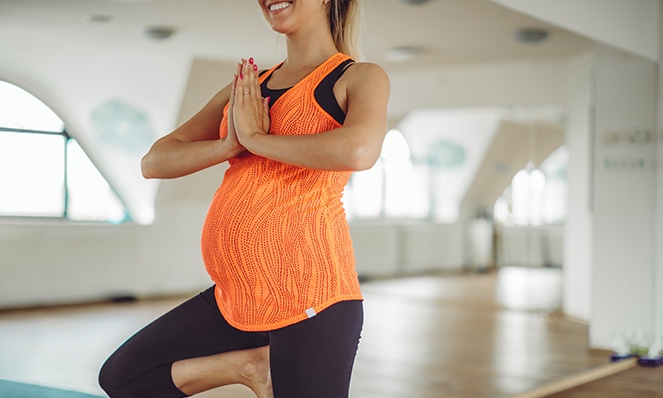Exercise Trends During Pregnancy: What's Safe?
Exercise Trends During Pregnancy: What's Safe?
Whether it’s your first Mother’s Day or an experienced mom who’s expecting again, here’s a look at which popular workout classes to try while you’re expecting and which ones to avoid.

Back in the day, doctors used to tell expecting moms to get as much rest as possible. We now know that’s not exactly true. It’s important to continue exercising throughout your pregnancy- with your doctor’s approval of course. A sedentary lifestyle during pregnancy leads to excessive weight gain, gestational diabetes and other complications. Plus, there is so many other benefits, it helps reduce stress, prevents depression, rids anxiety and keeps you flexible so you’re able to enjoy all the joys pregnancy brings.
However, it’s important to understand which exercises are safe and unsafe to partake in. Lucky for you, we’ve done the research so you don’t have to! Based on recommendations from Raul Artal, M.D., professor and chairman emeritus in the department of obstetrics, gynecology, and women's health at St. Louis University School of Medicine, Mo., and the main contributor to the American Congress of Obstetricians and Gynecologists' guidelines for exercise and pregnancy, we’ve deemed our classes safe and unsafe for you. If you’re thinking on beginning a new class, please consult with your doctor before you begin.
SAFE:
BarreOne
"Barre classes are a wonderful, mostly low-impact form of exercise for elongating your muscles," Pinto says. "I recommend against turns, jumps, and leaps after the first trimester due to your changing equilibrium and center of gravity, which makes a fall more likely, but slow-tempo exercises in the center and at the barre are perfectly safe. Even simple small jumps are okay when you are landing on both feet at the same time and you don't need to change your center of gravity." In other words, as long as you maintain your balance and stay close to the barre to grab onto and avoid falling, these classes can be a safe bet.
Swim
Hands-down, swimming wins the award for one of the safest exercises for pregnant women, experts say. "Swimming puts no pressure on your joints and ligaments, while the buoyancy of the water helps a pregnant woman not only exercise but also feel lighter while doing it," Artal says. You can certainly get a great workout and torch tons of calories without any impact. That's what makes this exercise one of the best bets for pregnant women. Be sure to check out our schedule for water classes that combine strength training and cardio in the water too! Running and walking in the water are great forms of exercise for burning extra calories.
Yoga
"The benefits of yoga are exceptional because it relaxes your mind and stretches your body," Pinto says. It can be an excellent way for an expectant mom to clear her head and deal with any anxiety she might have about her pregnancy or getting ready for the new baby. However, it's important to take some precautions. "Be mindful of the risk of overstretching in the second and third trimesters, when the hormone surges in your system to open your joints for childbirth, making strains more likely," Pinto says. Of course, avoid inverted poses like headstands and also lying on your back, especially if doing so makes you dizzy. As your uterus grows, lying on your back can put extra pressure on the blood vessels that bring blood back to the heart, causing your blood pressure to drop, Artal explains.
Spinning
"A spin class is a great option for a no-impact workout in a climate-controlled space that you can do at various levels of intensity, depending on how your body is responding," Pinto says. "You can engage in a high level of effort as long as you don't experience any warning signs such as dizziness, a racing heart rate, or blurred vision." However, you have to take several things into account, Artal says. For instance, make sure you don't become overheated. "When your core temperature exceeds 102 or 103 degrees, that can lead to birth defects during the first eight to ten weeks and can also lead to premature labor throughout pregnancy," he says. "Dehydration can also lead to premature labor." The key is to stay hydrated, avoid overheating, and use a lot of common sense.
Pilates
Similar to yoga, Pilates elongates your muscles while you coordinate your breathing to your body's movements. "Pilates is safe given that that you don't overstretch or, if you're using a reformer [specialized Pilates equipment], that you don't increase the level of resistance beyond what you could comfortably do before you were pregnant," Pinto says. Again, avoid lying on your back—you may need to ask your instructor for modifications.
Functional Training
While functional training may be controversial to some, there are safe ways to strength train while being conscious of the growing baby inside of you. Work with a trainer to help you move safely throughout your pregnancy. The trainer will watch your body and create exercises that will make you stronger and possibly reduce recovery time after delivery.
If you've been training long before your pregnancy — for instance, if you've been a five-miles-before-breakfast-no-matter-what kind of gal long before you became expectant, you're likely able to continue your regimen, so long as you get the doctor's okay. If you're the type who heads out to door to do a few miles January 1 and then promptly lose your runner sneakers until May, it's not best to start a rigorous routine now. With that in mind here are some not-so-safe exercises.
NOT SAFE: Trampoline, Hot yoga, Contact Sports, Heavy-Lifting classes, High-Intensity Training, Obstacle races
For more info on when and where we offer the above fitness classes, visit our website here. Remember to always share your fitness journey with us on Instagram using #IHaveOnelife.